Home » Blog » Emergency Repairs » Run Flat Tyres: Everything You Need to Know
Have you been offered run flat tyres for your car and want to know the pros and cons? Maybe you’ve just heard of them and you’re interested to know more about how run flat tyres work, what maintenance they require, and if they’re actually worth the extra money you’ll pay for them. If so,check out our complete guide below.
Run flat tyres are designed to remain safe and functional for a limited time with no air pressure. That means, in the event of a puncture, you can continue driving for around fifty miles without having to change the tyre — which could be enough to get you home, or to a garage.
Unlike conventional tyres, which require air to stay hard, run flat tyres have a reinforced sidewall, meaning they stay rigid without any air pressure.
The reinforced outer shell of run flat tyres keeps the rubber in place without air, supporting the car as you continue your journey. However, the sidewall isn’t designed to be permanent, and is only recommended for around 50 miles of additional driving after the tyre has deflated.
All cars that are compatible with run flat tyres have a tyre pressure monitoring system (TPMS), which is designed to alert the driver in the event of loss of air pressure. Without a TPMS system, it would be almost impossible to detect a puncture, given that run flat tyres will continue to work even when they’re deflated.
Most TPMS systems display an alert on the centre console, reminding the driver that they should stop driving after 50 miles and seek a tyre repair or replacement.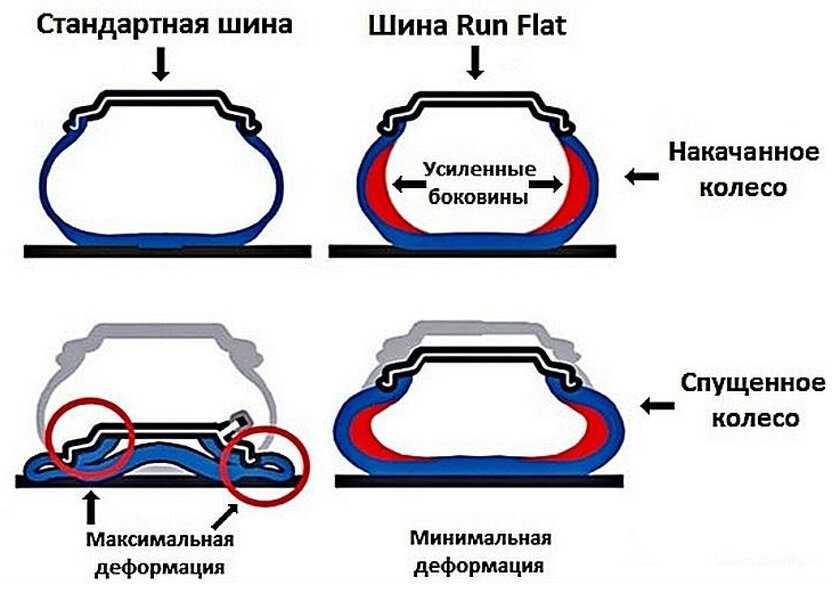
Generally, run flat tyres use the same rubber compounds as conventional tyres, so you can expect similar longevity. Despite their reinforced components, run flats will wear at the same rate as standard tyres, and require the same level of care and maintenance.
To keep your run flat tyres in good condition, check their pressure, depth and condition every fortnight. This will ensure you get maximum life out of your tyres before having to replace them.
Run flat tyres aren’t repairable. That’s because, once they’ve been driven on, they lose their structural integrity, making them unsuitable for puncture repair. If they are patched up, it’s highly likely they’ll puncture again down the line due to uneven wear and loss of rigidity.
And that’s their biggest drawback compared to conventional tyres, which can often be repaired reasonably cheaply after a puncture (provided the hole isn’t in the sidewall).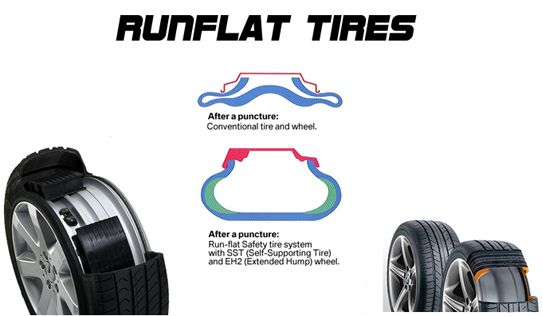 Given the expense of buying run flat tyres in the first place, each puncture could end up costing a small fortune.
Given the expense of buying run flat tyres in the first place, each puncture could end up costing a small fortune.
In a word, yes. Because run flats aren’t widely available, they tend to be a lot more expensive than ordinary tyres and can only be fitted to certain cars — putting them beyond the price point of the average motorist. Couple that with the fact they can’t be repaired, and they won’t make a whole lot of sense for most drivers.
If you don’t fancy paying through the nose for a car with run flat tyres, Holts Tyreweld Emergency Puncture Tyre Repair offers the next best thing. In the event of a puncture, this innovative DIY product quickly seals and re-inflates your tyre — allowing you to get to a garage without having to mess around with a spare wheel.
To find out more about our DIY car care range, visit our homepage.
Though they first appeared in the mid-1980s, run flat tires (RFT) are now more popular than ever. With some auto manufacturers making them standard in new vehicles, more consumers are asking about run flats, their advantages, and how using them impacts driving.
With some auto manufacturers making them standard in new vehicles, more consumers are asking about run flats, their advantages, and how using them impacts driving.
Run flat tires are tires on which you can continue driving after a puncture so you can take time get to an auto shop or find a safe, level area to change your tire.
You can’t drive on them indefinitely, though. Check the manufacturer’s specifications to find out how fast and how far you can drive on your run flat tires. Bridgestone run-flat tires will allow continued operation even after a loss of some or all inflation pressure for up to 50 miles (80 km) at a maximum speed up to 50 mph (80 km/h.)
There are two primary types of run flat tire systems: the self-supporting system and the support ring system.
In most self-supporting run flat tire systems, the tire features reinforced sidewall construction that will continue supporting the vehicle in the event of air loss. This construction allows continued operation after the loss of air pressure up to the speed and distance specified by the manufacturer.
This construction allows continued operation after the loss of air pressure up to the speed and distance specified by the manufacturer.
Support ring run flat tire systems, on the other hand, employ a ring of hard rubber or another structure that can support the vehicle’s weight in an air loss condition.
Since they continue performing even though they’re “flat,” all run flat tires, regardless of the specific system type, may only be used on a vehicle equipped with a Tire Pressure Monitoring System (TPMS). The TPMS alerts you as soon as one of your tires loses pressure. Without it, you might not know you were driving on an underinflated tire.
You don’t have to change your tire in dangerous or uncomfortable conditions. This is perhaps the biggest benefit of run flat tires and is the one of the reasons why they were designed. With conventional tires, you have to replace a flat on the spot or have your car towed.
In a puncture situation, run flats are more stable than conventional tires.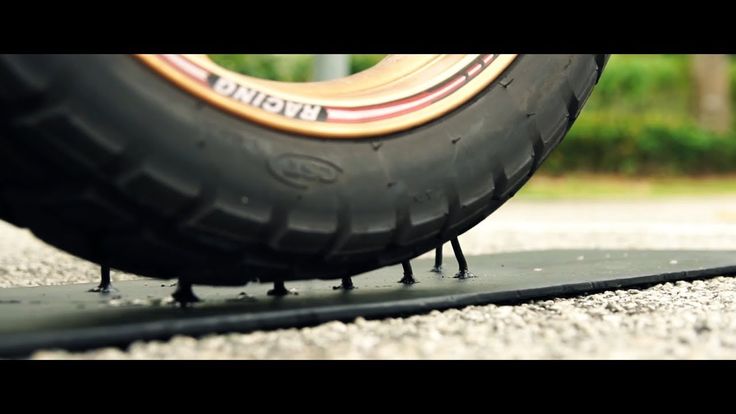 Since they’re made to support your vehicle even when they contain no air, run flat tires will help you maintain better control in a complete air loss situation than conventional tires.
Since they’re made to support your vehicle even when they contain no air, run flat tires will help you maintain better control in a complete air loss situation than conventional tires.
As consumers continue rating safety high on the list of features they look for in a vehicle, the popularity of run flat tires is expected to grow. Since run flat tires work reliably with interconnected technologies like TPMS, it may only be a matter of time before they become the norm rather than the exception in new vehicles.
There’s never a good time for a flat. That’s why Bridgestone DriveGuard tires are masterfully engineered to keep you moving for up to 50 miles at speeds up to 50 MPH without disruption.
See Details Find Your Fit
There’s never a good time for a flat. That’s why Bridgestone DriveGuard tires are masterfully engineered to keep you moving for up to 50 miles at speeds up to 50 MPH without disruption.
That’s why Bridgestone DriveGuard tires are masterfully engineered to keep you moving for up to 50 miles at speeds up to 50 MPH without disruption.
The tire pressure of a car varies with the outside temperature. Check your tire pressure in cold weather to improve your vehicle's efficiency and performance. Tire pressure provides good traction, support and control over your vehicle. If your tires are too low, you will burn more gas (which costs you extra money) or they may explode. If the tire pressure is too high, the vehicle may be difficult to control or the tires may deflate.
In cold weather, checking the tire pressure is especially important because it drops in direct proportion to the drop in outside temperature. Below are a few easy steps to check your tire pressure in cold weather so you can drive safely through the winter months.
If you notice that your tires look deflated or flat, it's time to pump them up.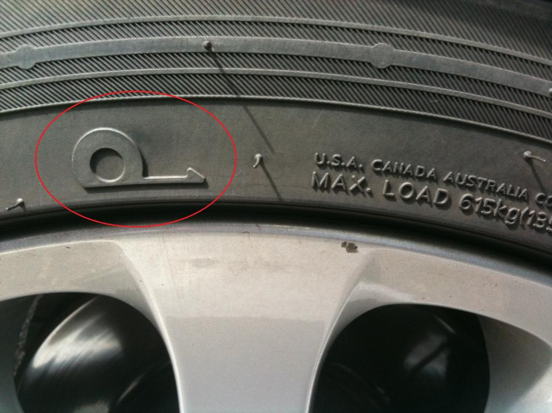 Typically, a tire looks like it's losing air and feels flat where it presses against the road.
Typically, a tire looks like it's losing air and feels flat where it presses against the road.
If you need to increase the air pressure in your tires, you will need to access the air pump. If you don't have one, you can drive to the nearest gas station.
Park close enough to the air supply so that the hose can reach the tires. If you only need to deflate the tires, you won't need an air pump.
Your tires should always be filled to the recommended safe pressure level. You can check the sticker on the inside of the driver's door or the owner's manual. It indicates the optimum pressure at various loads and temperatures.
Before adding or bleeding tires, you need to get an accurate idea of what pressure they currently have.
Tip: You should always let the tires cool down for a few minutes before checking the pressure, because frictional heat from road travel can cause inaccurate readings.
Required materials
Step 1: Unscrew the tire valve cap. Put it somewhere safe and easily accessible because you'll need it as soon as you're done.
Step 2: Place the tip of the gauge on the valve. Press it directly on the tire valve and hold it in place.
Tip: Hold the sensor level over the valve until you can no longer hear air coming out of the tire.
Step 3: Read tire pressure data. Your pressure gauge has either a numbered scale or a digital display. If you have a pressure gauge with a scale, make sure that you read the measurements correctly, which will help you markup. If you are using a digital screen sensor, read the data on the screen.
Depending on the current pressure level, you will need to either inflate or deflate the tires.
Step 1: Attach the air hose to the valve.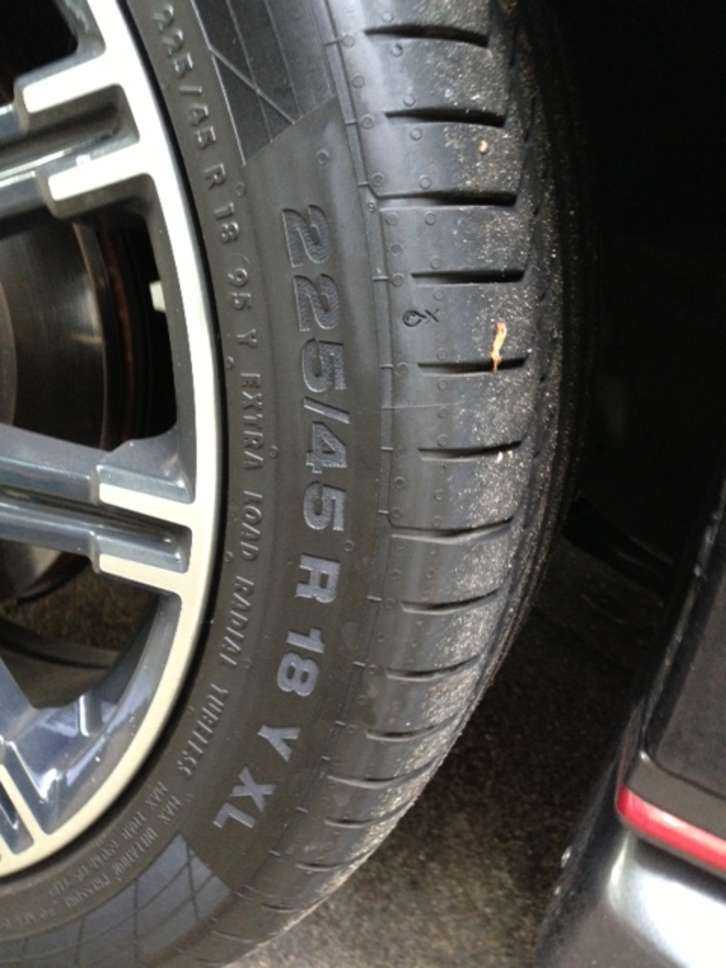
Take the air hose and attach it to the tire valve in the same way as the pressure gauge.
You will no longer hear air escaping from the tire when the hose is evenly pressed against the valve.
If you deflate, simply press the small metal tip of the air hose into the center of the valve and you will hear the air leave the tire.
Keeping your vehicle running is important to your own safety, and this includes maintaining proper tire pressure. Check your tires regularly, especially during the colder months when tire pressure deflates more quickly. Inflating tires is quick and easy if you follow this guide. If you notice that one tire deflates faster than all the others, or if you have a problem with inflation, be sure to contact a qualified mechanic.
Check your tires regularly, especially during the colder months when tire pressure deflates more quickly. Inflating tires is quick and easy if you follow this guide. If you notice that one tire deflates faster than all the others, or if you have a problem with inflation, be sure to contact a qualified mechanic.
We work around the clock Wheel balancing Removal and installation of wheels Puncture repair Tire Storage
Tires are one of the most important parts of your car, but changing tires can sometimes catch you by surprise. There's nothing like a flat tire on the side of the road to make you realize you haven't really looked at your tires lately - and maybe you should.
Here are 5 signs your tires are worn out and need to be replaced.
The Penny Test is the easiest way to test your tire tread and people have been using it for generations. To make sure your tires have enough tread to provide enough traction while you're driving, simply take a penny and place it head down in the tire tread. If you can see Lincoln's entire head, you're missing a protector.
Since tires may wear unevenly, it is recommended that a penny test be performed at several points on each tire. It's also a good idea to change your tires every few months so that the front tires don't wear out before the rears, or vice versa.
Most tire problems are best diagnosed when your car is not moving, but it's also a good idea to pay attention to it while driving. If your car vibrates a lot while driving, this may indicate a tire problem.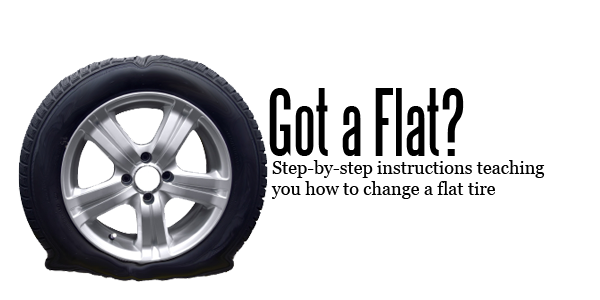 Of course, vibrations can be caused by poor alignment or bumps that need to be replaced, but no matter what, a lot of vibration while driving is no good and you should check it out.
Of course, vibrations can be caused by poor alignment or bumps that need to be replaced, but no matter what, a lot of vibration while driving is no good and you should check it out.
If you're wondering how to tell if your car is vibrating more than usual, try turning off everything in your car: radio, heater, air conditioner, and anything else that makes noise. Then go on a paved road without bumps and see how your car behaves. If it's a bumpy ride, you might want to go to a mechanic.
Tires can be damaged unexpectedly and often people may not realize they have damaged tires until they stop working. If you don't like dealing with unexpected flat or burst tires, it's a good idea to have your tires checked monthly to see how they feel.
When checking tires, look for anything unusual, such as cracks, dents, or bulges. These are all warning signs that your tires need to be replaced.